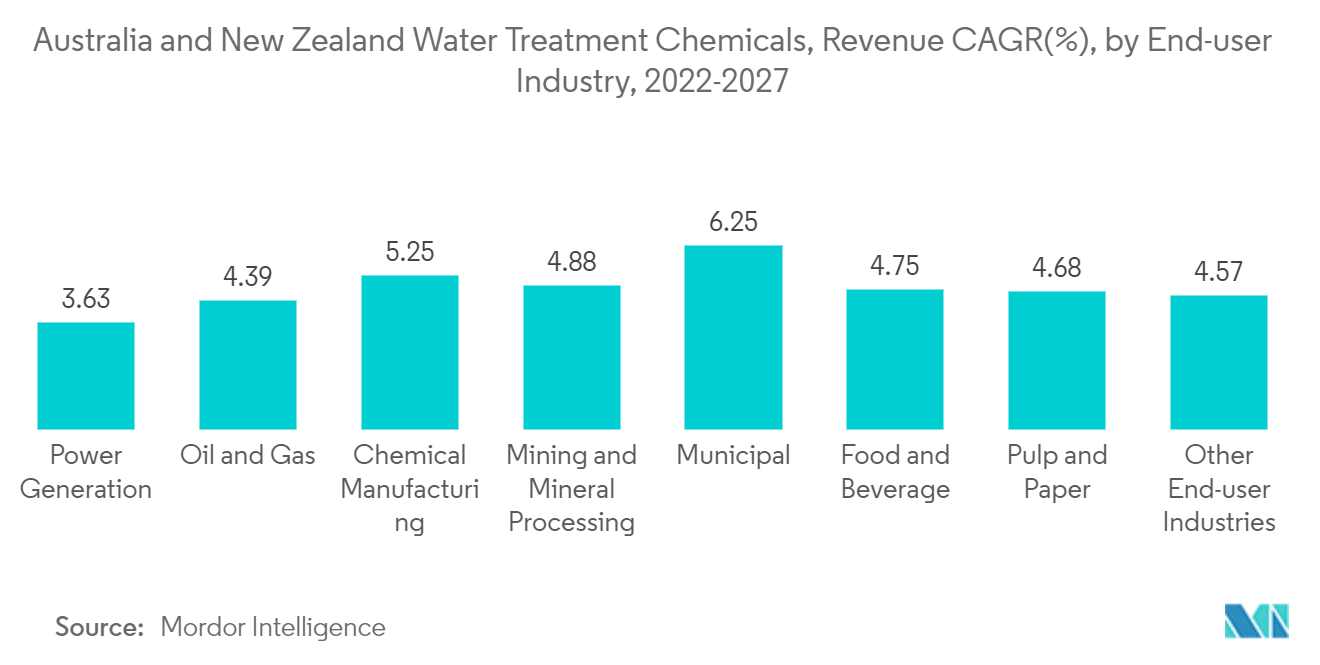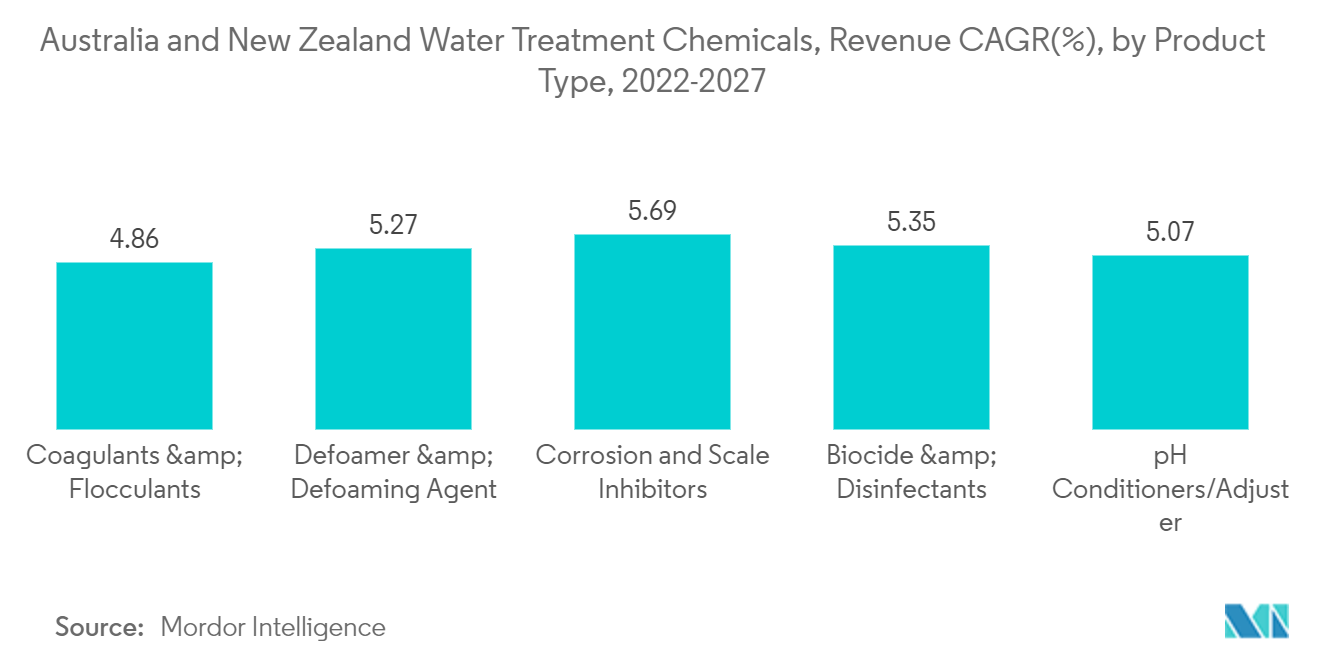Market Trends of Australia & New Zealand Water Treatment Chemicals Industry
This section covers the major market trends shaping the Australia & New Zealand Water Treatment Chemicals Market according to our research experts:
Municipal End-user Industry to Dominate the Market
- The supply of pure water to households is one of the principal requirements for all governments. The rising scarcity of potable water, coupled with the growing population and increasing water demand, is driving the need for the water treatment chemicals market in Australia and New Zealand.
- There are 140 different types of chemical contaminants depending upon the region. Chemicals chlorine, ozone, potassium permanganate, and copper sulfate are most widely used for removing chemicals and organic pollutants from wastewater. Activated carbon is also used in smaller quantities for removing pesticides, industrial solvents, and cyanotoxins.
- The Australian Government established the National Water Grid Fund as a USD 2.5 billion-worth 10-year infrastructure program to fund water infrastructure investments. As part of its 2021-2022 budget, the Government allocated funding to support new and improved projects. Australia spends an estimated USD 6 billion yearly on water and wastewater treatment services.
- Australia has a population of 26 million, and around 94% of the country's people are connected to the main water supply. There are approximately 300 urban water utilities in the country. Twenty-two utilities serve around 70% of the population. The smallest 200 utilities collectively serve 13% of the people, less than the number of customers of Australia's largest utility, Sydney Water.
- Also, around 85% of the population currently has access to more than 700 community sewage treatment plants. Nearly half of these are based on biological filters, about 170 are lagoons, and 45 are based on primary treatment. Most new plants are implementing activated sludge processes.
- According to the New Zealand Water & Wastes Association, 329 publicly owned wastewater treatment plants in New Zealand will have begun treating 427 billion liters of wastewater by the end of 2021.
- New Zealand municipal water treatment starts with pre-treatment, particle removal, and disinfection. According to the New Zealand Ministry of environment, pre-treatment involves a pre-oxidation method using oxidizing chemicals such as chlorine, ozone, and potassium permanganate.
- Hence, owing to the aforementioned factors, the municipal industry accounts for a significant market share and is expected to fuel the market growth during the forecast period.

Corrosion and Scale Inhibitors to Dominate the Market
- Corrosion inhibitors are general-purpose chemicals that deal with corrosion in boilers. Corrosion occurs when oxygen reacts with metallic parts in a boiler to form oxides. Corrosion affects the metallic parts of the boiler, thereby increasing the costs of energy and maintenance. Corrosion inhibitors form a thin barrier layer over the exposed parts of the boiler. Scale inhibitors are used to remove scales through chemical processes.
- Several types of corrosion inhibitors are used in water boilers. These include condensate line corrosion inhibitors, diethyl hydroxyl amine (DEHA), polyamine, morpholine, cyclohexylamine, and carbon dioxide corrosion inhibitors. A mixture of filming amines is used to prepare condensate line corrosion inhibitors. This can provide protection due to the presence of both high and low vapor/liquids.
- DEHA is a volatile compound that is also an oxygen scavenger and acts as a metal passivating agent. Polyamine can be used in both low- and high-pressure boilers. Morpholine protects the boiler by increasing the pH level of the liquid. Cyclohexylamine is used in low-pressure boilers. Carbon dioxide corrosion inhibitor is used along with polyamine to control corrosion.
- The aforementioned inhibitors are also used in cooling water treatments to ensure metal protection and prevent metal loss. The absence of these inhibitors may lead to critical system failures in recirculating water piping, process cooling equipment, and heat exchangers. Corrosion inhibitors are added to treatment systems to protect metals by reducing the corrosion potential associated with the cathode and anode of the corrosion cell.
- The most serious form of corrosion occurs in cooling water treatment systems containing steel and copper alloys. Multi-phase processes, such as pretreatment, coagulation, flocculation, and corrosion control, occur during water treatment. Among these processes, the corrosion inhibitor is added after filtration to avoid fouling. As a countermeasure, corrosion inhibitors are added to prolong the service life of piping throughout a water distribution system.
- Furthermore, corrosion inhibitors are among the key chemicals used in the oil and gas industry. Corrosion inhibitors are the backbone of a strong asset integrity program that keeps equipment failure rates in check. They are used to safeguard wells, pipelines, tanks, compressors, and practically every other type of downhole or surface equipment. Oil and gas producers, transporters, and refiners would suffer greatly if corrosion inhibitors were inaccessible.
- The growing demand for solutions to avoid corrosion during processing across various end-user industries leads to the demand for corrosion inhibitors, which leads to the growth of the market studied.
- Carbonates and bicarbonates form from calcium and magnesium chemicals dissolved in water. This residue matter gets deposited on the boiler surface and forms a hard coating known as scales. Scales block efficient heat transfer, create localized heating, and increase power consumption and maintenance expenses.
- The most demand for scale inhibitors comes from the oil and gas and petrochemical industry, which is gradually recovering and is expected to impact the market studied.

